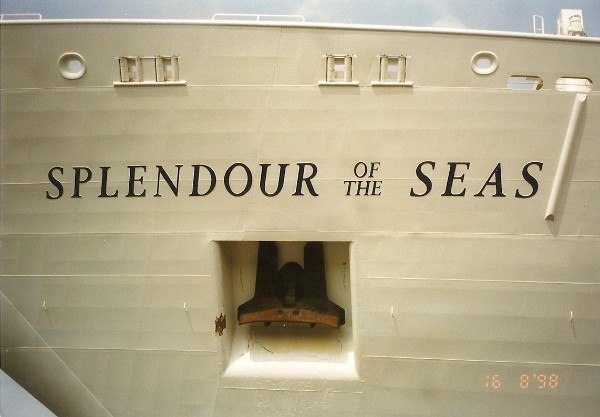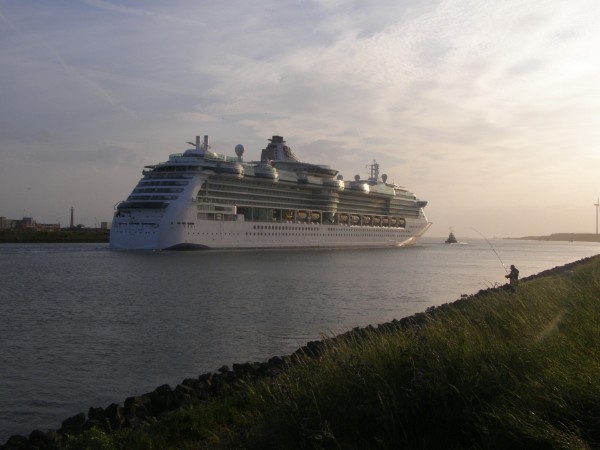Royal Caribbean International
The man behind the start-up of the Royal Caribbean Cruise Line was named Edwin Stephan. He had been the general manager for a company named Yarmouth Steamship Company, owner of the Yarmouth Castle and Yarmouth. In november of 1965, the 1927-built Yarmouth Castle, one of the two sisterships sank after she had caught fire off the Florida coast and 88 passengers and 2 crewmembers died in the tragic incident. The disaster also spelled the end for Yarmouth Steamship Company and Stephan joined a new company named Commodore Cruise Line. But as Stephan was a man with a larger vision, he didn't stay long with Commodore as in 1967, he undertook a voyage to Norway to meet up with several shipowners with whom he wanted to start up a new, modern line.
The first of those was Sigard Skaugen of I.M. Skaugen, a company that had expertise in the design and building of oceangoing ships and one of their employees, Martin Hallen, was to become the designer of the first ships for the new company. The second party was Anders Wilhelmsen & Co., that was going to provide accounting and management. Just when negotiations started, Anders Wilhelmsen died and was succeeded by his son Arne. They were in desperate need for more investment and so the parties were joined later on in 1969 by Gotaas-Larsson, owner of one of the worlds largest fleets of cargo-bulk ships. Just before they joined the consortium, that was named Royal Caribbean Cruise Line, Gotaas-Larsson had also aquired the Eastern Steamship Lines company, whose ship Bahama Star co-incidentally had rescued the survivers of the Yarmouth Castle in 1965. This aquisition was made seperately from the RCCL involvement and it was decided that Eastern Steamship Lines was to be no larger then two ships as the other investors were not willing to compete with a company owned by one of the investors in RCCL.
To really make the company financially sound, Stephan was sure that they needed at least three ships. One for the simple seven-night Miami-St. Thomas voyage and two for longer fourteen-night cruises to other parts of the Caribbean. Where the money came from the three parties, the general ideas were those of Stephan. He wanted the ships to be easily recognizable and he suggested that something based on the Seattle Space Needle should be built on top of the ships. Stephan was intrigued by the Space Needle since his visit to the Seattle World Fair in 1962. His first idea proved to be too costly, but because the designers found the funnel the most ugly part of a ship in general, the cheaper proposal was made to wrap a lounge around it. With Norwegian tradition in mind, it was called the Viking Crown Lounge.

Three ships were indeed ordered from the Wärtsilä Yards at Helsinki, Finland and were recieving traditional Norwegian-styled names by the shareholders. The 22.000-ton Song of Norway (Skaugen) was delivered first in 1970, the Nordic Prince (Wilhelmsen) followed in 1971 and the last one became Sun Viking (Gotaas-Larsen). The ships all flew the Norwegian postal banner, a flag formerly used by Norwegian mail-carri-ing ships and they were registered in Oslo. Although they worked together, all parties seemed to have their own idea about running the line and as we all know, a ship with so many captains is sometimes hard to steer. But the company seemed to do very well from the beginning onwards and RCCL instantly became the premier cruise line sailing out of Miami, leaving competition far behind. Within a decade, it was decided to lenghten two of the ships and a new one was ordered in december 1979, the soon-to-be 31.000-ton Song Of America. She entered service in december of 1982. In 1987, the company took delivery of yet another cruiseliner, this time she was the largest ship in the world with a tonnage of 73.129. Not only she was the biggest sailing cruiseship at the moment, she was also the fourth largest passengership in history only surpassed by the Queen Mary, Queen Elizabeth and Normandy of the 1930's. Her name was Sovereign Of The Seas, the first ship with the now familiar namestyle and a groundbreaker in the history of Caribbean (and world) cruising.
More new ships were added to the fleet of Royal Caribbean Cruise Line in the 1980's, still with several problems between the shareholders, something that also sometimes delayed the newbuilding process. In 1987, this came to a larger problem as Gotaas-Larsson combined their Eastern Cruise Line, Western Cruise Line and Sundance Cruises into a new company named Admiral Cruises. As it had been decided in 1969, it wasn't meant for Eastern Cruise Lines to expand beyond two ships and now there were three and another one on order. As a solution, a merger was planned between Royal Caribbean and Admiral Cruises as Royal Admiral Cruises, in which both lines would keep their seperate identities. But something else was also at the horizon. Because Gotaas-Larsson was the only one of the conclomerate that was a publicly traded company, the companies financials were to be reviewed by other parties. One of those was Carnival Cruise Lines and they agreed to take over the shares of Gotaas-Larsson within RCCL, who would then also be able to built up Admiral Cruises as their own line in competition with RCCL. But because all three shareholders had to sell and agree before a sale could be made, a dispute arose. Skaugen needed the money for their survival and agreed, but Wilhelmsen didn't. In thirty to fourty days, they had to arrange the money to buy out the others and stop the Carnival bid and they succeeded by calling in the help of the Pritzker family of the Hyatt hotelchain and the Israeli shipowner Samuel Ofer. So after a lot of problems between the shareholders and Carnival, RCCL stayed an independent company under ownership of the new parties and Carnival took over Holland America Line instead three weeks after the deal collapsed. Since that time, Carnival and RCCL are knowing to be real competitors and no friends what so ever. Because of the buy-out of Gotaas-Larsson and I.M. Skaugen, also Royal Admiral Cruises was off the table and Admiral Cruises was absorbed into Royal Caribbean with the former Stardancer of Sundance Cruises becoming the Viking Serenade and the planned Admiral Cruises newbuilding was launched as Nordic Empress.
Below, the line's trademark, the Viking Crown Lounge, is pictured. This one is from Legend Of The Seas. The lounge, wrapped around the funnel of most ships of the line, was added because the designers found the funnel the most ugly part of a ship so something had to be done to make it nicer. An idea from Edward Stephan was to make it look like something as the 'Space Needle' in Seattle.

All early Royal Caribbean ships which names ended on 'Of The Seas' were built on the Chantiers de L' atlantique-wharf in St.-Nazaire, France. This illustrious row started with the Sovereign-class in 1987 when Sovereign Of The Seas floated out. Two more Sovereign-class ships were built after the buy-out of the others by Wilhelmsen, Monarch Of The Seas in 1990 and Majesty Of The Seas in 1991. These ships were meant for the growing Caribbean market, as stated in the name of the company also. Since their debut, they kept sailing in this region.
The older ships of Admiral Cruises were sold and Nordic Empress took over the cruises from Emerald Seas. One of the stops on this cruise was Little Stirrup Quay, a small island that had been established by Admiral Cruises in 1983. RCCL renamed the island Coco Quay and it's just a stone-throw away from Norwegian Cruise Line's Great Stirrup Quay. The island is used as an exclusive stop for ships of RCCL and managed accordingly.

Royal Caribbean started out to built up their fleet and mostly, these ships broke the records of the largest passengerships ever built. This started with the very large Eagle Class, where the
Voyager Of The Seas was the leading ship. This class of five measured around 137.000 tons, dwarfing the Grand Class that was just introduced by
Princess Cruises. Next up, the colossal Freedom Class was built, headed by the
Freedom Of The Seas who'se tonnage measurement was 155.000. Three ships were built in this class. But they were not done, when they introduced the Oasis-class of four ships, starting with the monstrous
Oasis Of The Seas of 225.000 tons. It is very likely that this class will stay the largest class of passengerships for a long while to come. Next to introducing larger tonnage, the older ships were sold. The first trio was sold to a new venture in the Mediterranean, named Airtours Sun Cruises. Strangely enough, this company was largely owned by Carnival Cruise Lines, RCCL's biggest rival.
Next to the building of the own fleet, like Carnival Corporation, Royal Caribbean expanded their operations through aquisitions of other lines. In 1997, they made a huge jump when they bought
Celebrity Cruises, the cruise-division of Chandris Cruises. They quickly build up the fleet of this line, making it one of the most modern fleets in the cruise-industry. After the aquisition, Royal Caribbean Cruise Lines became the mothercompany and Royal Caribbean International became the new name for the original cruiseline. Under the Celebrity Cruises brand, two sub-brands were started up, Celebrity Xpeditions and
Azamara Cruises. Also, RCCL entered the Spanish market through
Pullmantur Cruises, in which they placed older tonnage from the main fleet from 2007 onwards. Royal Caribbean sold 51 percent of this company to the Madrid-based investor Springwater Capital in may of 2016. In 2003, RCCL tried to merge with
P&O Princess Cruises, but this became a failure and Carnival stepped in and took over this business instead. This long and complicated story is too extended to tell here. In june of 2018, rather surprisingly, Royal Caribbean bought also a 66,7 percent stake in luxury company Silversea Cruises. Through this aquisition, RCCL is able to tap into more luxury markets. Silversea kept it's own identity and own management under the new owner.
Royal Caribbean also started up a company catering for the French market under the name of Crocieres de France in 2007, sailing European cruises in European summer and during the other months the company is seen in the French Caribbean. This company was sold for 51 percent to the Madrid-based investor Springwater Capital, together with Pullmantur.
A ship that has also sailed for Royal Caribbean is placed elsewhere on the site

